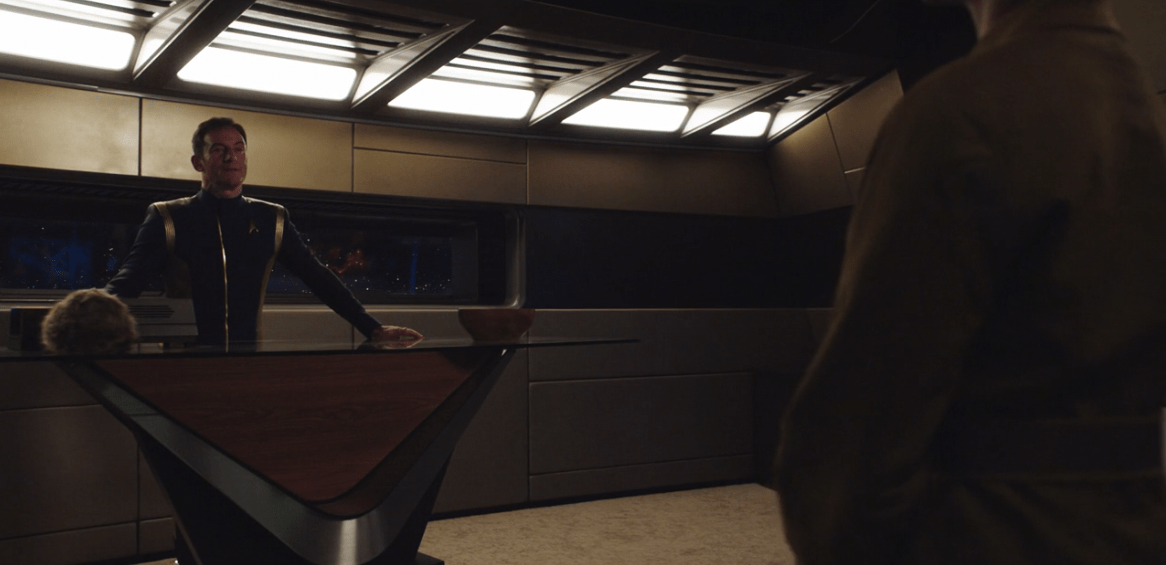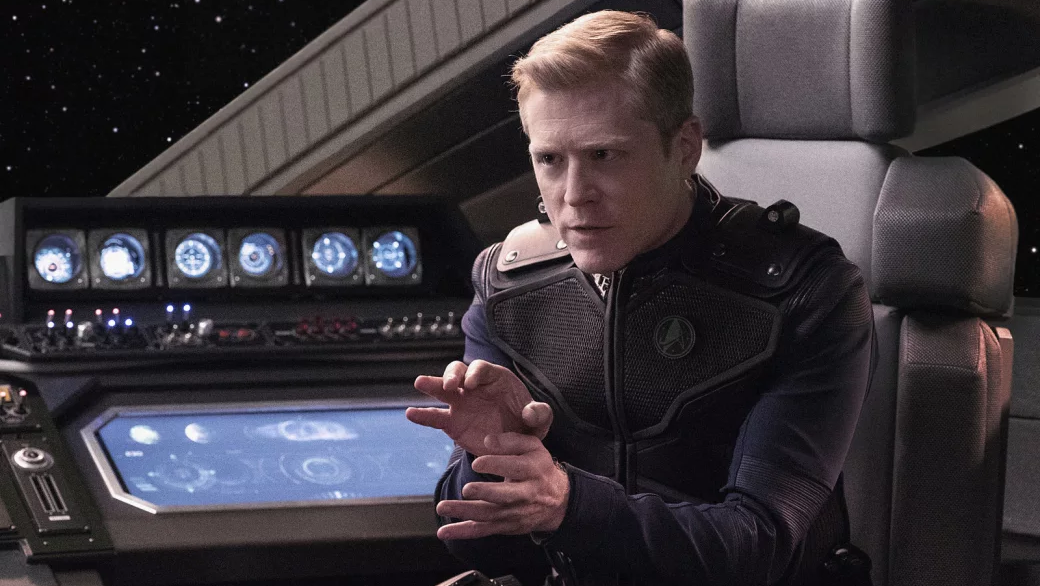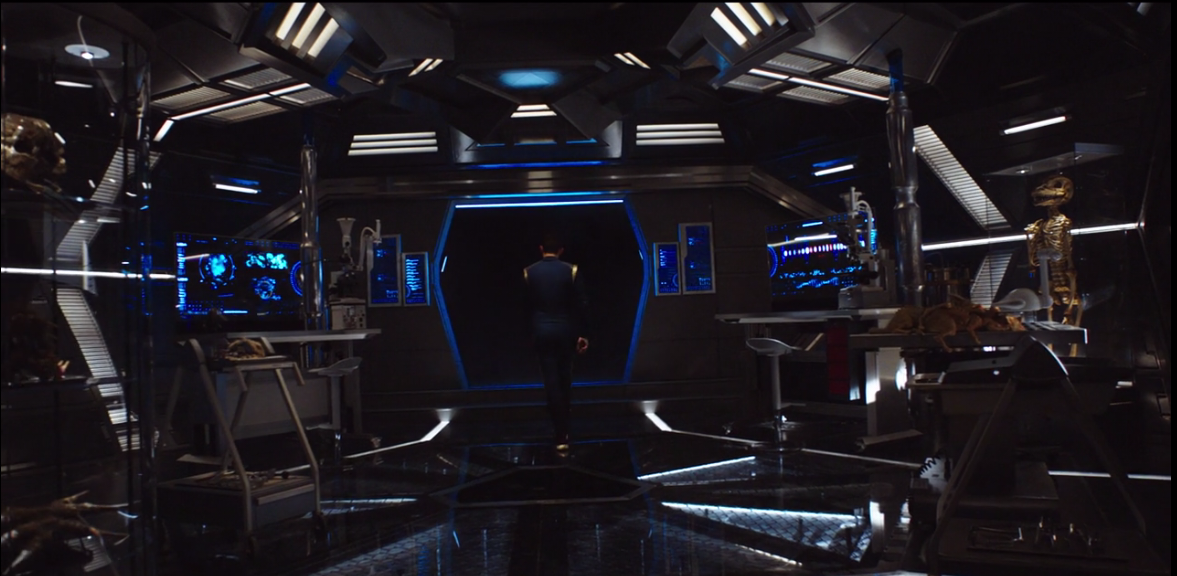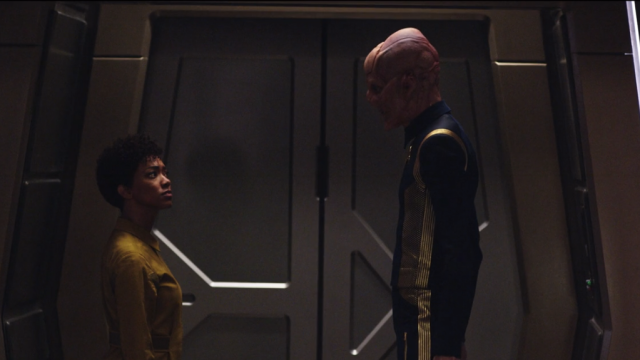The third episode “Context Is for Kings” is the first true episode of Discovery, and it’s a big improvement over the two-episode TV movie that kicked off the series last week. The characters are more interesting now, the ideas smarter, and the world better understood. Granted, I may be biased because it’s also examining a Trek issue I’ve been dying to see tackled.
All images: CBS

We’re six months past the end of the first two episodes, which ended with Burnham getting sentenced to life in prison for her mutiny against Georgiou. She’s since been transferred from whatever prison colony she had been on to one where she and other prisoners are going to act as miners for the war effort. Except, of course, not. Since a disaster strikes the shuttle, and it’s rescued by the USS Discovery, NCC-1031.
On the Discovery, Burnham and the other prisoners are met by the ship’s chief of security, Commander Landry (Rekha Sharma, whom you might remember as Tory Foster on Battlestar Galactica). She takes the prisoners to get food, and Burnham is attacked by the other prisoners, and defends herself. Landry waves down a security officer who is about to intervene and, once Burnham has taken her assailants down, says the captain wants to see Burnham. Either the summons took place during the fight, offscreen (unlikely), or this was an incredibly weird and roundabout test on the part of the captain who instructed Landry to take them to get food, not interfere in any confrontation Burnham got involved in, and, after she resolved it, bring her up to him, still not having eaten.
On her way to the Ready Room, Burnham sees Saru again, since he’s the First Officer of the Discovery. Actually, he’s one of two Discovery officers that Burnham sees on the ship, which is a science vessel with the ability to run 300 research projects simultaneously. (I bet a lot of this show is going to be pulling out various projects to study/go wrong. As a framing device, that’s a good way to do some classic Trek standalone episodes.) The ship also has people with “black” badges — remember that instead of blue, red, and gold, divisions on this show are gold, silver, and bronze. No one’s seen black before, but I expect that we’ll find they’re based in Article 14, Section 31 of the Starfleet Charter, which allows for extreme measures in the event of existential threat. Section 31 provides headaches whenever it shows up, so good luck to everyone!
Burnham meets Captain Gabrial Lorca (Jason Isaacs) who has a medical condition that requires him to get adjusted to bright light slowly, which is probably why he’s on this research ship and not at the front lines fighting the war. This is a malady that’s going to be a bitch for the show to keep including, so I bet Discovery will mostly ignore it until it wants to use it a major plot point. That Lorca likes taking risks, he has a chirping Tribble on his desk. And to think, he has the Klingon’s weakness right there, and doesn’t even know it!

He tells Burnham that no one travels on his ship for free, so she’s going to work while the prison shuttle is repaired. She’s assigned — and confined to — quarters shared by Cadet Sylvia Tilly (Mary Wiseman), a brilliant engineer who is also the prototypical nerd with allergies and problems relating to others. If there was one place I wish had dispensed with this particular cliché, it’s Star Trek.
During the night, there’s a “black alert,” because… sure, why not add a new alert? And Burnham sees water drops hover and then fall back down.
Saru escorts Burnham to Engineering, and they have a nice moment where Burnham compliments Saru on the speech he made at Georgiou’s funeral and tries to apologise. Saru says he believes she is sorry, but also that she is dangerous, then leaves her in the hands of Paul Stamets (Anthony Rapp), who is my brand-new favourite. I didn’t want him to be, but here we are.

I’ll explain why: Stamets has a call with a friend and former research partner, who is doing parallel research on USS Glenn. He talks about how their research is too slow for the happiness of Lorca, whom it is clear he does not like. Then the Glenn suffers a cataclysmic accident after doing a trial run of the same research that the Discovery is apparently behind in, so Stamets, Burnham, Tilly, Landry, and redshirt rush in to salvage the research.
During the journey, Stamets tells Burnham that he and his dead friend were happy in a lab, doing amazing research. Then the war started, their research was co-opted, they were separated so that they’d be “twice as fast” in their work, and Stamets had to work for the “warmonger” Lorca. And this? This is the idea I have been waiting for Star Trek to explore forever. Even Deep Space Nine, which also featured a war that tested the limits of Starfleet and the Federation, never delved that much into the fundamental tension of Starfleet’s stated mission of exploration and its military side.
I wanted Star Trek: Into Darkness to go into this. I wanted the Kelvin timeline to show how the Kelvin incident would give the hawks in Starfleet a chance to mould the institution into something less science-focused and more defence-focused. I wanted that conflict — and the hawks winning more than they did at the same time in the Prime timeline — to make having two timelines actually mean something more than “we don’t have to worry about continuity.” Obviously, that didn’t happen.
Discovery actually seems to be looking at this. Rapp plays Stamets as both in love with the science, and furious about how he’s being forced to research it. It’s a perfect Star Trek conflict, and I am here for it.
Anyway, on the Glenn, the team discovers the crew have all died, and their bodies hideously deformed. There’s also a Klingon boarding party killed by a creature of some kind. Tis creature pops up, the redshirt is killed, Burnham distracts the creature, and the crew gets away.
Burnham accuses Lorca of putting her through tests because he’s doing experiments to find a biological weapon that is in violation of the Geneva Conventions (apparently, there was a second one in the 22nd century). And that he wants her because she’s smart, has a scientific mind, and clearly has no trouble going around Starfleet’s rules. He counters by showing her that the biological particles they’re studying allows them to travel nearly instantaneously across the galaxy. Burnham accepts his offer.
Of course, Lorca also has Landry beam aboard the deadly creature to the xenobiology lab on the Discovery. And on that ambiguous note, the episode ends. I’d take bets on whether that comes back to bite them in the arse, but the “Next time on” preview makes clear that it does.

Assorted Musings
- I still hate that we don’t have colours on these uniforms. The “division by metal colours” is too subtle and when a redshirt is not in red (or gold, in later seasons), it ruins some of the fun.
- As my colleague Alex Cranz pointed out, Stamets research can never actually work. Otherwise, many years in the future, a newly made Admiral Janeway is reading the classified file on it, and cursing. Granted, running a ship on biological constructs is also how Voyager was built. It was a mistake. (Also, this is why prequels are a bad idea. We could have easily done this exact show, set past all the Prime universe shows and movies, and substituted the Klingons with a new race, and it would have worked and avoided these kinds of problems.)
- The old Trek technobabble has returned. “Miss” isn’t the right term for how I feel about it, but, hey, at least it’s an authentic Trek staple.
- Lorca says that his family used to be in the fortune cookie business. The modern fortune cookie — the light-coloured ones Lorca keeps on his desk inadvisedly close to a Tribble that could turn that food into a billion more tribbles — were supposedly first served in San Francisco. Just a reminder that San Francisco is the most important city in the galaxy according to Star Trek.
- Speaking of San Francisco, that’s where Starfleet Academy is, and its motto is “Ex astris scientia,” or “from the stars, knowledge.” So Stamets saying he joined Starfleet because of wonder lines up with how it’s presented.
- Burnham insists she just wants to serve her time. Of course, she also breaks into a lab on the Discovery using her roommate’s drool and a hypospray, so it’s roughly on the same level of credibility as everyone saying how Vulcan and coldly logical she is and then her proving she’s the exact opposite.
- Burnham reciting Alice Adventures in Wonderland while running from the creature was… weird. It felt off and was just so they could have her say Amanda Grayson read her and Spock the book when she was growing up (also because it’s an original Trek Easter egg).
- I’d be lying if I said the panning shot across the Discovery didn’t take my breath away.
